Boba Fett Mystery Helmet Customization Guide:
I eventually began some dialogue with a member of the 501st Legion who referred me to an individual who was considered THE source for the Boba Fett Mystery Helmet - a helmet that is a direct cast from the original mold used in the Star Wars Classic Trilogy (and not sold through "normal" distribution channels).
The helmet earned its nickname because the origin of the helmet is somewhat of a mystery. A popular rumor is that when Don Post acquired the license to sell replica Star Wars props, a copy of the original mold was sent to their facility. Don Post opted to scale the helmet, thus differentiating it from the actual screen used version (and for those of you who have owned either the inexpensive $69.00 version or even the more expensive Deluxe model, you know what I mean). The story goes that someone at Don Post made a mold from the copy sent by LucasFilm, but did so for personal use, which eventually made it to the general public through unconventional distribution channels. I don’t know if this is true or not, but simply what I’ve been told.
The helmet shown on this page was allegedly cast from the mold that produced the original Mystery Helmet (which was previously used to produce the Fett helmet seen in ESB).

Please note that while I have 27+ days written down here, they were not successive, but actually taking place over a span of nearly four years (as noted below). The majority of my work began in the summer of 2007 and was finished in late summer 2008. Well over 55 hours were invested in customizing this helmet.
It is also important to note that I am neither a master painter or skilled craftsman. I am just a "normal guy" who has a passion for Star Wars with a particular interest in Boba Fett (some people close to me say "obsessive"). The purpose of this Web page is to hopefully assist and encourage similar individuals who want to get involved in a project such as this, but are apprehensive about doing so.

Additional prop item(s) you will need:
Range Finder: Various vendors offer metal range finder stalks.
Visor: (Updated for 2016) Hobart 770580 Face Shield Replacement Lens from Amazon.com
Note: Do NOT purchase the visor by Rembrandt Industries through eBay. The curvature of the lens is too extreme and hardly pliable to accommodate the Mystery Helmet. It's also not any good for the Don Post or Rubies helmets despite Rembrandt's claims to the contrary.
Supplies Needed:
Paints: Floquil, Testors and Polly Scale Paints. Due to the extensive supply needed, I purchased some of mine through Hobbylinc. For a color listing, please look further down this column.
Paint Thinner: Do not confuse paint thinner with acetone. Some paints, such as Polly-Scale will gum-up if you try to dillute them with acetone. Use a bonafide paint thinner such as Testor's brand if you intend to dillute your paint for airbrush use.
Primer: Krylon white
Sandpaper (you will need both fine and rough grit sandpaper).
Bondo in the event you make a minor cutting mistake. Bondo comes in a few forms, but you would want the one in a tube.
Masking tape: Standard masking tape as well as a painters tape with less adhesive (1" and 2.5" variety)..
Liquid Nails: Adhesive recommended for affixing the ear pieces to the helmet.
Loctite Super Glue: Adhesive recommended for fine glue work. Easily identified by its orange/red buttons on the bottle's sides.
Tools Needed:
Airbrush: An expensive unit is not needed. I went with an entry level model by Badger that attaches to an aerosol can.
Dremel with cutting discs and one sanding point (resembles a cone).
Electric Drill with a very fine bit (optional for cutting out key slots in back of helmet).
X-Acto Knife (optional) for getting to those hard to reach corners of the T-Visor, and for trimming the rear key-slots if you choose to cut them out.
Paints Needed: Floquil, Polly Scale and Testors Paints. Due to the extensive supply needed, I purchased some of mine through Hobbylinc, others through Tower Hobbies. For a color listing, please look further down this column. All paint recommendations are by Rogue Studios of The Dented Helmet.
Panzer Olive Green: Dome, lower cheeks, left earpiece.
PRR Green: Upper cheeks
Green RLM 73: Back of helmet below "headband"
Caboose: for T-Visor/mandibles area and "headband."
PRR Maroon: Various places on T-Visor/mandibles and "headband."
Earth: Range-finder ear pieces
Chrome Silver (or bright silver): Base coat, portions of right RF ear piece
Personal note: You can purchase the chrome either in the 1oz bottle size (for airbrushing) or in a spray can by Testors. While the airbrushing is easier in terms of a reliable coat, the Testors spray is much easier to use (overall) and is cheaper too.
Rust: Various areas.
Reefer Yellow: Vertical stripes on left side of helmet. UP Armor Yellow could be used as an alternative as it's very close in color.
Concrete: Damaged area on back, half-circle on left ear piece.
Light gray: Various areas.
Lark Dark Gray: Various areas.
Green RLM 25: Green splotches on back of helmet
Flat Black: Range finder top, designs/markings on ear pieces.

2004 Day 1, Cutting: This is what the helmet looked like upon receipt. It was a cast made from some sort of resin material, and of a beige-like color.
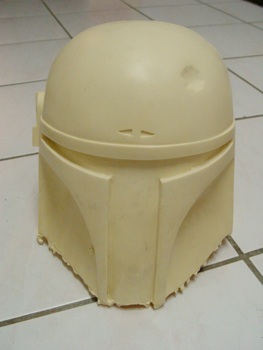
2004 Day 2, Cutting Part 2: The "key slots" in the back were a nightmare to cut. So, similar to what I did with the Don Post helmets I customized, I took a fine drill bit and drilled tiny holes into the key slots, each key slot having about 7 or so mini-holes. This allowed me to then use an X-Acto knife and cut through with greater ease. Again, I had to use sandpaper to get the key slots fairly straight and uniform. You will obviously have to custom-cut some sandpaper so that it fits neatly into each respective key slot so that you can slide it back and forth to smooth out any roughness from your initial cuts. Any mis-cuts (i.e. uneven lines) can be repaired with Bondo. Apply bondo with a popsicle stick, let dry, and use fine grit sandpaper to smooth out the rough edges and to get the even lines you are looking for.
If this sounds too difficult to do, you may want to just keep the key holes the way they are. The choice is entirely up to you.
Once this was done, I lightly sanded down the entire helmet and then wiped off any remaining residue. This was in preparation for my next step: Priming the helmet.
2004 Day 3, Priming: I chose to use standard white primer paint (Krylon) and misted the helmet from about 12-14 inches away. One of my personal priming techniques is to take a broom, prop the brush-end of the broom against something on the floor so that the handle is pointing straight up. I then spin the helmet on the broom handle as I am priming. This allows me to get even coverage without the worry of applying too much paint to a certain area resulting in paint drips. In the hot summer sun, it also aids in more uniform drying over the surface of the helmet too. I let the initial coat of primer dry for several hours in the hot summer sun, and then applied a second coat of prime
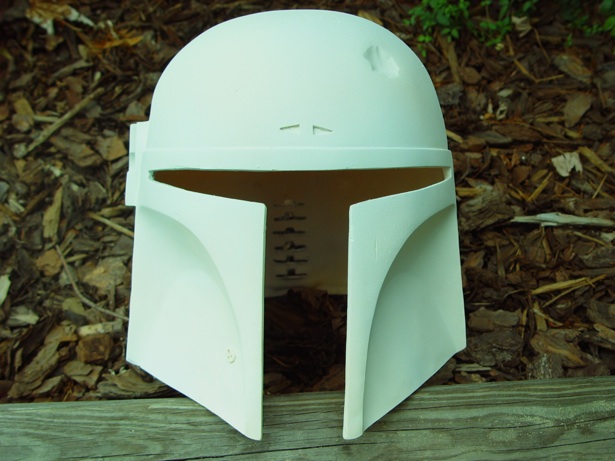
After the completion of this stage, I got side-tracked with a ton of other things going on with my life, and simply put the unfinished Mystery Helmet on display in my "Fett Shrine" for nearly three years.
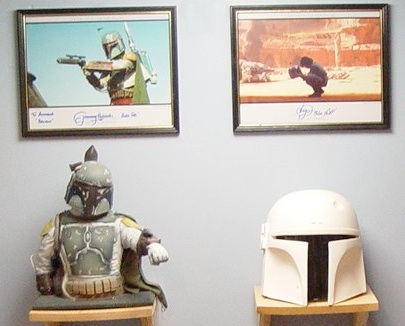
2007 Day 1, Sanding & Trimming:
When revisiting this project after so much time had passed, I made it a priority to complete the initial phase of trimming the helmet to spec.
I took my Dremel and used what I call a "sanding cone." You can purchase this separately for about $5.00, or, with one of those multi-piece kits that are available at places like Wal-Mart or Home Depot.
Challenge #2 in prepping the Mystery Helmet was to reduce the thickness of the visor. Once I had the T-area cleared, it was about 1cm deep which is way too recessed. I used the sanding cone and removed excess resin from inside the helmet. This was very tricky because the Dremel could only be held at certain angles, and there were many tight spots to contend with (especially near the corners of the eyes!). The first thing I removed were the resin "drippings" on the inside of the helmet that partially obstructed the area I needed to thin out. Then, I worked from the bottom of the T-visor area, up towards the eye areas. I would advise using eye protection for this phase of the project. For the far outer corners of the eyes, you may need to switch to a sanding disc versus the cone. Just use caution because if you press down too hard, you will make the T-area uneven. Just make gentle touches with the sanding disc to get the correct depth and distance around the eyes.
I should also note that you need to be EXTREMELY CAREFUL because if you wear too much material away, you will be up the creek so to speak. Not even Bondo can help if you make the t-visor area too thin.
When I got close to what I felt was accurate, I chose a rough grit sandpaper to wear down the resin a bit, and then switched to a fine grit sandpaper to make the area as smooth and even as possible, both behind the T-visor where no one will see, as well as the visible portions that lie in front of the actual visor (when installed).
The helmet was cleaned off with a dry rag to remove all the resin dust both inside and outside the helmet.
I dusted a bit more primer to the newly surfaced areas and let dry for a full day.
2007 Day 2, Base Color:
Using an air brush, I used chrome paint (3 parts paint, 1 part thinner), and covered the entire surface area of the helmet. I let this sit in the baking sun for about four hours, and then let the helmet sit overnight without any more work done to it.
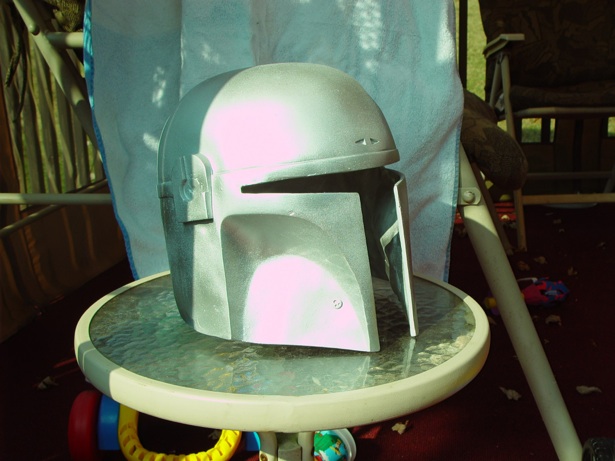
2007 Day 3, T-Visor Color (aka "mandibles"):
The first area I chose to focus on was the T-visor area. Carefully masking the portions outside my area of initial focus, I used regular masking tape for the areas directly surrounding the T-visor area and "headband," and painters tape for all other areas. The painters tape has less adhesive making it less likely that you'll pull the chrome off when removed. Regular masking tape needs to be affixed for the areas surrounding your paint-work because it will stay tight to the helmet thus reducing the likelihood of paint running behind it to parts you don't want colored. Use Floquil "Box Car Red" for this area (3 parts paint, one part thinner).
I should note that some people have difficulty masking the T-visor due to the curvature. I'd recommend using 6" strips of masking tape and "bending" the tape as shown in the close-up two pictures below. It can be done with patience, and the end result is well worth the effort made.
Let dry for a few hours before attempting to remove the masking tape. The finished job should look as follows:
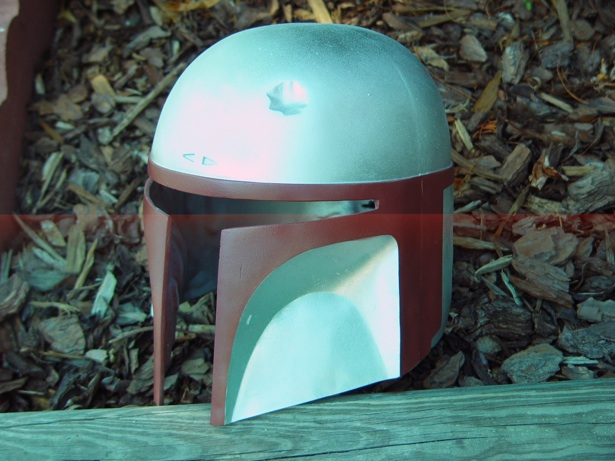
2007 Day 4, Upper Cheek Color:
The next stage of my project involved painting the upper cheeks (the area between the t-visor and the lower, more flat area of the cheeks). Masking this area can be very tricky due to the curvature both above (where it meets the T-visor) and below (where the lower cheeks are). Additionally, you won't want to use regular masking tape to cover the red "T" area. Doing so will result in paint being pulled off when you remove the tape. Use painters tape (such as the purple color variety by Duck Tape). It has a mild adhesive that will not remove the paint. Just be sure that it is secure to the area you want masked because with light pressure, it will lift off. Additionally, I would recommend using many small strips in order to follow the curvature of the area you want masked off. Unlike regular masking tape, you can't bend the Duck Tape because the adhesive doesn't bond as well.
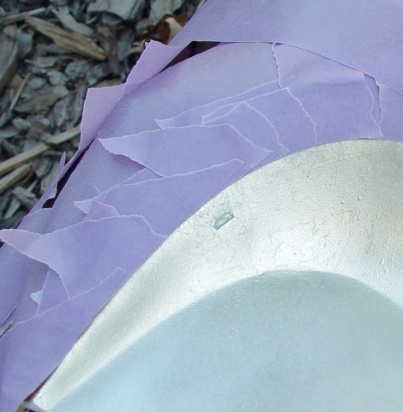
For the lower cheeks, you can use regular masking tape since the chrome color won't peel off when the tape is removed.
I used Floquil PRR Green; 3 parts paint, one part thinner for this area. I believe this is also called "Brunswick Green" - which is almost a black.
I used an ultra fine-point modeling paint brush to smooth out the curved lines with the PRR green, though, with the masking technique described above, not much hands-on work will be needed.
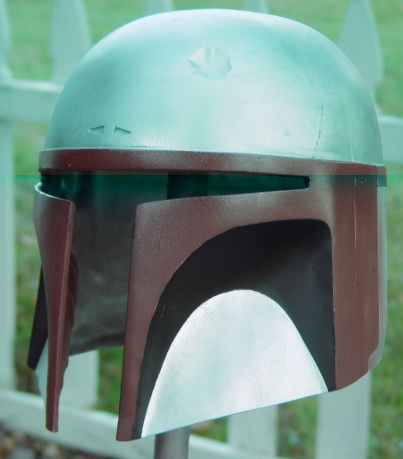
Once again, my digital camera is casting a shadow on the helmet which is not really there (noticeable to the right of the eye slot on the ear piece area).
2007 Day 5, Dome and Cheeks Color:
Both the dome and cheeks require Floquil's Panzer Olive Green. Very carefully mask off the upper cheeks (the dark color) using the purple painter's tape, and the red visor/headband area. Because the purple tape doesn't lock out every bit of spray (due to it's low adhesion), you may have to do some touch up work with a brush or spray later on to the upper cheeks and visor/headband area later.
I recommend applying a minimum of three coats to the dome, and two to the cheeks. After the first coat, let dry for several hours in the sun (if possible), then re-apply.
When finished, carefully remove the painters tape so that you don't tear the previously painted areas.
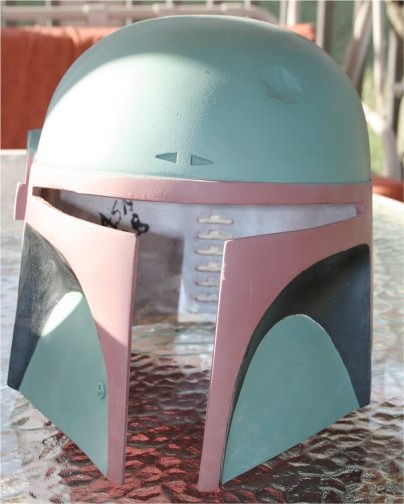
2007 Day 6, Back Color:
The "back area" pertains to the portion behind the ears, below the "headband," but excluding the recessed key-hole area.
Use Green RLM 73 for this area of the helmet, masking off the headband and red ear-area with purple painters tape and regular masking tape for the key-hole area. This can be a very difficult color to find - and Tower Hobbies was the only place I found to carry it. That being said, if you do order it through Tower Hobbies, make sure you speak with a customer service rep and explain that you want the bottles checked for freshness prior to them being shipped. I had three separate shipments of coagulated RLM 73 paint that were completely un-useable. Upon insistence of having someone physically open bottles to verify the consistency, I was finally able to get fresh bottles of RLM 73 on the fourth shipment Unfortunately, this matter put me a full-month behind schedule. I was not charged for the previous three shipments, and the customer service department was trying to be helpful throughout the ordeal.
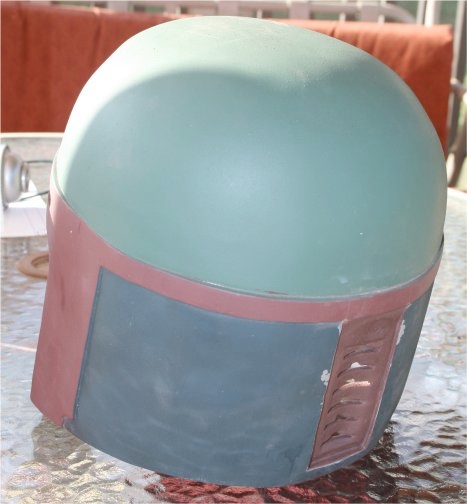
2008 Day 7, Key Holes (Back) Color:
Masking off all areas of the rear of the helmet except for the recessed key-hole area, use Floquil "Caboose" color paint for this section. Here, I painted it by hand, let dry, and then lightly dusted the area using an airbrush to remove any brush strokes that might have been showing.
2008 Day 8 & 9: Touch up to cheeks, headband area, and re-paint of mandibles.
Because I used painter's tape for most of the front work, there are some paint dust marks from where my spray seeped underneath the masking tape. For this, I carefully masked just enough to allow me to make a fine paint line that separates the lower cheeks from the upper cheeks. I chose a fine point hobby paint brush to do this delicate work.
2008 Day 10-11, Ears Color:
The ears of the helmet will first need to have any rough edges sanded down with a very fine grit sandpaper. I would also recommend slightly sanding down the surfaces of the ear pieces so that the primer will adhere better than if you just sprayed it on the smooth surface.
Begin with a light dusting of primer so that it adheres, and provides a better tackiness for the second coat. Trying to get complete coverage on the first try will result in pooling of paint as it runs down the convex shape to the corners. I would recommend a light dusting on your first try, a medium dusting on the second effort, and the third coat should completely cover the pieces.
Once completely dry (about four hours later), spray a single layer of chrome to cover the outer surfaces.
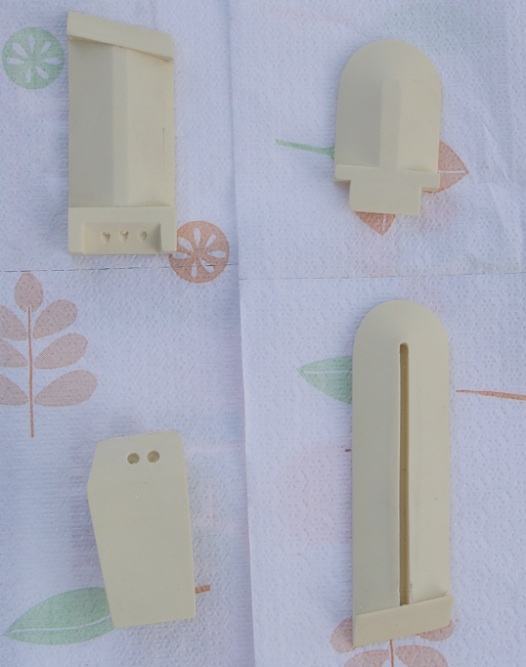
Here are the four unassembled helmet pieces in their raw form.
Let dry for a day in the sun if possible, and add the following colors to the appropriate pieces.
- Left ear piece: Panzer Olive Green
- Right ear piece: Earth
- Chrome bright silver (portions of right ear piece)
- Flat black: Range finder top
(I address this again further down this page, on "Day 18")
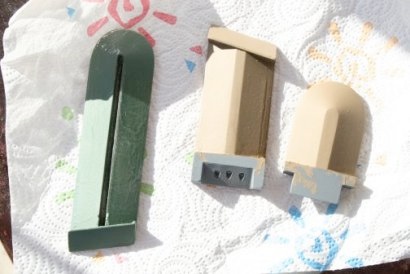
Above are the ear pieces after a first coat of paint. Since some of the Earth paint seeped through the masking tape (right ear pieces), I had to lightly sand it down so that it would not show when later applying the metallic color to those areas.
2008 Day 12, Adding Vertical Stripes
There are a number of ways you can you can do this. The easy way is to buy pre-cut vinyl stickers specifically made for a 1:1 scale Boba Fett helmet. These can be found at various 501st member sites, or maybe even eBay. I chose not to use stickers on my helmet and had to figure out a way to do this myself.
I first downloaded the kill stripe template from The Dented Helmet and printed it out on paper that wasn't too flimsy. I then took 2" purple Duck Tape brand tape and applied it to a catalog that had a glossy cover (so that the adhesive would still be reasonably good when carefully pulled off later).
I laid the template over the masking tape and cut out the template with reasonably hard pressure to make sure my cuts were clean. I'd recommend using an X-Acto knife which makes this task much easier than a typical razor. Unfortunately for me, I had misplaced my X-Acto knife and had to use the knife pictured below.
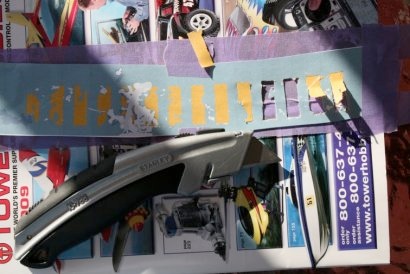
If you choose to use this method to cut out your kill stripe stencil, make sure to use 2" painters tape and affix it to a surface that is likely not to remove the tape's adhesive; for instance, a glossy catalog cover or a glass table. While I used a box cutter blade, I'd highly recommend an X-Acto knife for this project. I wish I could have found mine! It would have made doing this a whole lot easier.
Once the stripes are cut out, carefully trim the tape so that it matches the curvature of the template you downloaded. This will allow you to place the tape-template against the helmet's "headband" so that the stripes are even as they wrap around the dome.
Cut the new tape-template into quarters so that they can wrap around the side of the helmet without warping or wrinkling. Be sure to line them up carefully so that they (i.e. the four sections) are equidistant to each other and to the headband.
Press the tape-template firmly to the helmet making sure there is no lift around the small cutouts you made.
Mask the rest of your helmet so that paint will not get on it during the upcoming painting process. When masking here, I used strips of 2" of purple Duck Tape brand tape above and below the target area, and then taped paper towels elsewhere to prevent waste of additional tape (and to save money!).
I highly recommend using an airbrush from about 14" away and lightly dust the area at first. Do not focus on one area too long otherwise the paint will drip beneath your tape-template and create a mess. Just lightly spray the kill stripes with Reefer Yellow and take a 15 minute break. You should still see a lot of green still showing. After your mini-break, spray another light coat over your previous work, and let set for 15 more minutes. You should now have mostly yellow showing. A final light coat should do the job. Let this dry for an hour before peeling off the mask/template. You do not want wet paint to mark areas that you did not intend it to be on.
If for some reason you have paint that leaked behind the tape-template, don't fret! It can be fixed, though you will have set yourself about an hour behind schedule. See my trouble-shooting tip below for help if this happens to you. If everything turned out okay, you should give yourself a pat on the back because this is pretty tricky to do!

Here you can see how no messes can be found between my stripes, this was due to careful masking. Any slight bleeding from the kill stripes can be taken care of with the "scratching method" of battle damage described in the next section.
Trouble Shooting: If you opt to use a paint brush as opposed to an air brush, you will likely encounter paint that drips behind the mask you applied. The end result will be quite a bit of yellow paint between the kill stripes. Additionally, air brush paint application isn't fail-proof either. You could end up with yellow paint residue outside your target areas. If this happens to you, I have two solutions which worked well for me in the past.
First things first: Don't panic!
Second, cut out small strips of masking tape that are just big enough to cover every stripe. Don't make them too long otherwise your "repair" will be more obvious (trust me). Now, take a piece of tape and cover up one stripe so that you are perfectly aligning it to one side. Take another piece and put it on the nearest stripe aligning it perfectly the side facing the other masked stripe. This will expose the green area in between where you have unwanted yellow paint. Repeat this process across the rest of the kill stripes (though be aware that because of your tape placement, some stripes will have to be corrected later on).
Take very fine grit sand paper and gently wipe down the yellow paint residue between your masked areas so that your surface is once again smooth. Take a dry paper towel and clean the area. Mask off all of the exposed red areas on the helmet (T-Visor area, headband, ear area, etc.).
Now, using your air brush with loaded Panzer Olive Green, lightly spray the area with a smooth back and forth motion. Do NOT focus on a single area. You do not want so much paint accumulating that it actually looks wet. You just want to lightly coat the yellow this first time around. Once you have some green covering the yellow, stop and wait about 10-15 minutes for it to dry. Apply a second coat of green to the affected areas. At this point, there should be very little yellow showing. Stop, and wait another 10-15 minutes. Your final coat should effectively cover any of the residual yellow between your kill stripes. Let dry for a full 30 minutes before removing the tape.
Now, repeat this process for the other areas of yellow between the kill stripes that you couldn't get the first time around. Follow the same process outlined above.
If you have yellow bleeding above and below the kill stripes, simply align your painters tape to the top most portion of the stripes that you want to keep, thus exposing the areas you want to "clean." Follow the same three step process of painting, drying, and re-coating.
When you are finished, your stripes should look really good.
As a final note, earlier on in this section I mentioned to use masking strips about the size of the stripes. If you use extra long strips of tape, you will show paint lines on the dome making it obvious that you did repair work. If this happened inadvertently, simply mask off your stripes horizontally with a big strip of painters tape so that the green area above each stripe is exposed, and lightly air brush Panzer Olive Green from about 14"-18" away starting right on the masking tape, and brushing upwards to the top of the dome. This will gently blend in the paint making your paint marks invisible. Only one or two light coats will be needed here.
2008 Day 13-14, Battle Damage Phase 1: (Scratching):
The purpose of scratching is to give the illusion of battle damage by revealing the chrome silver undercoat. There are two tools you will need for this phase: 1) a fingernail (or thumbnail) and 2) a butter knife without a serrated edge.
As you well know, there are numerous scratches all over Boba's helmet, but in my opinion, there are about 8 notable ones that you should focus on trying to get reasonably accurate. They are:
1) Dent in right forehead (if you are looking at the helmet)
2) "Fire scratch" on left forehead (if you are looking at the helmet)
3) Right mid-cheek area (if you are looking at the helmet)
4) Right mandible area (if you are looking at the helmet)
5) Left mandible area (if you are looking at the helmet)
6) Long scratch at top of helmet
7) Left back side of helmet.
8) Scratch around 5th kill stripe from left.
In my efforts, I tried to match as many as possible without becoming obsessive compulsive. For the most part, I identified the major scratches and locations and started with those. I then tried to locate mid-size scratches and worked on those next. Then, I looked to the smaller scratches to even out the appearance. From there, I took a little creative license and "invented" some of my own.
To begin, start with the main dent. Try scratching off the green paint with your thumbnail and work around the dent. If you find that you are having problems removing the paint, use a very dull butter knife and try to get the scratching started, and go back to using a fingernail if you want. Try not to dig too deep so that you get into the resin. You only want to remove the top coat of green.
When you are through, step back and observe what your helmet looks like. If it is to your liking, great! If you feel that your exposed chrome undercoats are a bit too dull, simply use a fine paint brush and apply a fresh layer of chrome silver over the chrome base. Be careful though, you may leave unwanted brush strokes.
If you opt to have brush strokes visible, be certain that they are consistent in direction. For instance, if you decide to brush what I call the "fire scratch" (left forehead of Boba's helmet if you are looking directly at it), make sure that your brush work begins on the red mandible and that you brush in the direction of lower right to the upper left leading to the fire scratch. This will create an illusion of impacted metal traveling in a constant direction to the upper left of your Fett helmet. If you disregard this, the damage will not look consistent with textured "metal" in all different directions.
As a final note, be sure not to apply chrome paint over any areas that should not be "damaged" if you are working with the scratch method (as opposed to the topical method).
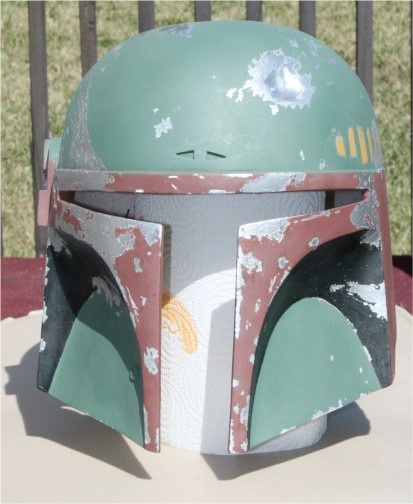
2008 Day 15-17, Battle Damage Phase 2 (Painting & Weathering ):
If you are right handed, I'd recommend starting on the left side and when finished applying both colors, taking an hour break to let the paint dry completely before starting on the right side. This is a delicate process, so you want each area to be completely dry before moving on. After doing the mandibles, you should have a pretty good idea how this light gray/dark gray process works.
I next moved on to the cheeks. The Light Gray is no good over the Panzer Olive Green so stick exclusively with the Lark Dark Gray. Since these are pretty key weathered marks, try to nail down their exact location, and come reasonably close to their pattern.
Once those dried, I moved on to the top of the helmet and began working around the three big scratches (dent, "fire scratch," and long top scratch). When those dried, I finished my work with the smaller scratches on the dome of the helmet.
I next worked on the headband area around the helmet - following a bit of the MR helmet as well as using personal discretion.
I next worked on the sides of the helmet which didn't have all that much to do (since the ear pieces will later be covering the bare sides).
Finally, I tacked the back of the helmet which was a nightmare. If you've seen the movie production helmet, or the MR helmet, it's an unpatterned mess of four colors: Concrete, Light Gray, Lark Dark Gray, and Green RLM 25. The #25 green is really odd, and there are only a flew blotches of it on the rear right side of the helmet.
My pattern on the left side of the helmet is fairly close to the pattern on the MR helmet, but using the three colors to "dress up" the enormous scratches was a daunting task. So many times did I want to leave "well enough" alone. I did my best with this section, and moved on to the right which was even tougher because it had even less of a shape than the left side. Do your best here. The back of the helmet is supposed to look like a mess, and well........just remember that. If you want to apply the Green #23, go for it. If you don't -- that's fine too. I opted to use it.
Finally, I weathered the red key-hole box area using both the Light Gray and Lark Dark Gray colors in similar fashion to the MR helmet. It wasn't precise, but fairly close.
As a finishing touch, and a personal touch (since this isn't in any of the real or replicated Fett helmets), I took a piece of screen (from a screen door), painted it Box Car Red, and with six touches of Krazy Glue, applied it to the inside of the helmet against the key holes. Getting air is important when wearing a helmet like this, but yet you don't want people to see you very well either. So, this mesh screen adds a bit of difficulty to see through, yet allows air to pass. I also have a black screen piece too which I may try later.
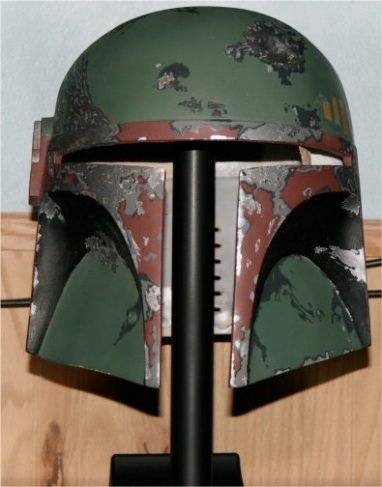
The shadows are a bit deceiving in this photo as they mute the brightness of the dent and scratches found on the dome.
2008 Day 18, Painting and Assembling the Ear Pieces:
When painting the ear pieces, be sure to mask off the portions of the ear pieces that will be metallic in color (i.e. the right ear pieces). Plan on three to four sessions of very light coats each time for all three pieces. Because of the curvature of the pieces, focused spraying will result in pooling or excessive dripping. Just use light coats each time until you have full coverage on the out surface and on the thin sides.
- For the left ear piece, use Panzer Olive Green.
- For the left ear piece, use Rust or PRR Maroon for additional weathering/damage effects
- For the right ear piece, use Earth for the non-metallic portion.
- For the metallic portions of the right ear pieces, you can use either Chrome Silver or Steel. I initially used Chrome Silver, but found it to be too shiny - almost fake looking. So I sanded it down and went with Steel. In my opinion, Steel looked remarkably better.
Note: When using metallic colors like Chrome Silver or Steel, give ample drying time before handling. For some reason, and from my experience, they require extended drying time when compared to regular colors. If you can go without handling them for a full day after painting, that would be in your best interest.
I'd also recommend applying the Earth color to the right ear pieces first and allowing to dry for a few days before masking off for application of the metallic color.
When your ear pieces are completely dry, download a template for the ear pieces (i.e. at The Dented Helmet), and in similar fashion to how I did the kill stripes, place the template over painters tape and cut it out. Apply the tape template on your ear pieces, and mask off everything else.
For the left ear piece, use Concrete for the the half circle.
For the right ear piece, use Flat Black for the horseshoe.
Tip: If you have a VERY fine point paint brush, you can apply (by hand) the symbols found on the ear pieces. If you find that your brush is too soft despite being fine point, dip your brush into the Flat Black paint and let it dry. This will give it a hard, pencil like feel. Re-dip into the black paint, and draw in your designs!
2008 Day 22, Installing T-Visor
Cutting out your T-Visor from a welder's shield can be tricky, but I'd recommend starting by placing the visor on the OUTSIDE of your helmet, and marking the outline of the T-pattern with crayon or chalk, giving your self 1" extra all around when you cut.
With your new shape, try inserting it in your helmet. Chances are, it will be too big. Re-mark the visor again and trim as needed.
You will likely be close, but still off the mark by just a bit. Re-mark, and re-trim if necessary.
When you can get a good fit, determine which method of affixing the visor would be best for your situation. You can use something permanent like Liquid Nails, double-epoxy, or even screws. If those methods concern you, you can try something semi-permanent like industrial strength Velcro that has a durable adhesive backing. The only challenge would be affixing it to the lower portion of the visor area (around the mouth/chin) where there isn't much room for Velcro squares or strips. I personally would use either Liquid Nails or a double-epoxy.
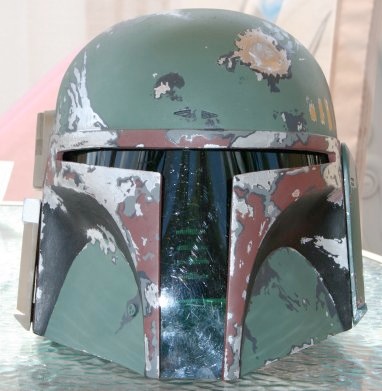
2008 Day 21, Interior Padding/Lining
I went to a local fabrics store and purchased a yard of 1/2" foam to which I measured to fit the interior of the helmet sides. Due to the fact that I wanted installation to be as easy as possible, I measured the left piece of padding to begin just to the right of the key-hole area all the way around the interior left, and to the T-Visor. I cut out the key-hole area (for breathability when wearing the helmet) and trimmed accordingly for the T-Visor. I then measured out the right portion of the padding and trimmed the T-Visor area accordingly.
Using material of your choice, I would recommend using a spray adhesive to apply the material over the foam padding. 3M makes a decent spray adhesive, though it reeks something fierce. Be sure to use it in a well ventilated area. Also, I'd recommend wearing disposable latex gloves too as the adhesive can get very messy, and sticks to EVERYTHING. Some of the spray may bleed through your cover material once you apply it to the foam padding, and you don't want the adhesive to touch your skin. When finished, let it all dry for about an hour. Once dry to the touch, cut out the key-hole area and trim appropriately.
From there, install the padding sections using something like adhesive Velcro strips, Gorilla Glue, 3M Spray, or Liquid Nails (all depending on how permanent you want this to be). I'd recommend making the back and side padding permanent, but with the front visor area being semi-permanent (i.e. using industrial strength Velcro). My reasoning for this method is that if you need to change your visor for some reason, you can peel back the padding up front and access the visor for removal.
For the top of the interior helmet, cut out a circular shape to fill what's not currently padded. You may even want to cut out the very center of your new circular foam (so it looks almost like a doughnut) in the event you want to install a "head band" of sorts that hugs your head better - though, that may not be necessary depending on how your existing padding set up is. With my setup, the helmet fit snuggly and securely to my head.
Once you get the shape needed, spray adhesive on the foam circle and secure your material over the foam. Once dry, affix to the top interior of the helmet using whatever glue you choose.
You should now have a nicely padded helmet, though fairly smelly due to all the glue. I'd recommend leaving the helmet upside down for a day or two in the sun so that the interior gasses out. As bad as this interior work smells after being completed, the MR Boba Fett helmet was as bad if not worse upon delivery due to the glues they used. My MR 501st Legion Clone Trooper helmet took over a year and a half to gas out!
Note: Prior to doing any of this, you may want to paint the lower interior portion of the helmet (i.e. the bottom 2") black or whatever color your interior padding is in the event someone gets a partial peak underneath if/when you wear it. It will look more uniform this way.
2008 Day 23, Installing Range Finder
Depending on where you get your range finder stalk from, you may find installing the RF to be easy or difficult. The one I ordered was a steel stalk complete with a screw, washer, and nut.
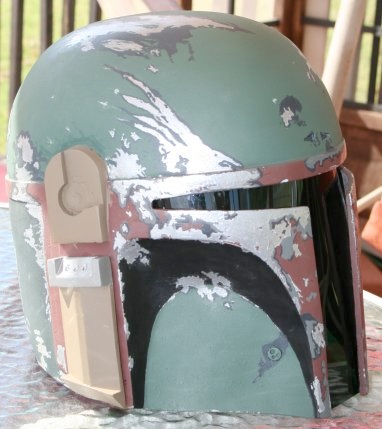
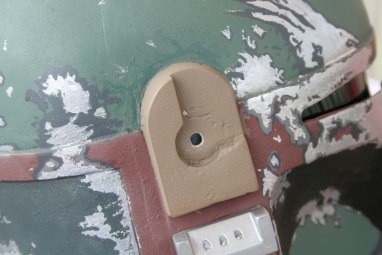
Placing the RF stalk to the helmet, I screwed in the bolt and tightened accordingly from the inside. Please note that the tighter you make it, the more pressure will be required to move the RF up and down. The downside of this is that you will be filing away your paint job as well helmet's resin material at its anchor point (the color you painted "Earth").
What I did was rock the RF stalk back and forth filing away the "excess" resin from the helmet. This of course pulled the paint right off the contact area. After I felt satisfied with the movement of the RF, I removed it and re-painted the area by hand (it won't be seen due to the "cap" that eventually goes over it). I re-bolted the RF back on, carefully glued the cap over the RF, and gently checked to make sure no glue came in contact with the moving parts (which thankfully did not happen).
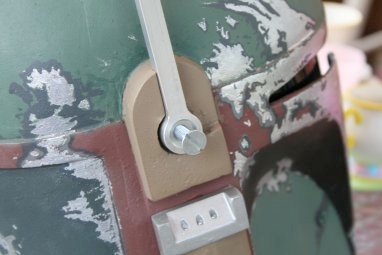
2008 Day 24, Miscellaneous Items
Now that you are almost finished, you may want to take notice of the small details that really make a difference - - such as the small symbols/glyphs on the ear pieces.
Very similar to my process for creating the kill stripe stencil using masking tape, I downloaded a template for the left ear mark (half moon shape) from The Dented Helmet. I placed the half-moon symbol where appropriate, masked the rest of the helmet, and lightly dusted Concrete paint over the open area. I did this three separate times with three very light coats in order to help reduce or eliminate any potential dripping. I hand drew the small symbol using a rigid fine point paint brush (this can be done simply by letting paint dry on the brush head for about an hour so that it becomes hard, and then re-dipping the tip into fresh paint).
On the right ear-piece, I made creative use of masking tape to create the mini tally marks, the "blotch", and the "T" on the range finder parts. Before the paint was fully dry, I placed a piece of purple painters tape OVER my new paint work, and pulled it off almost immediately. This pulled some off some of the wet paint, thus leaving the remaining images "weathered" and "worn" looking. The effect actually turned out very well. For the symbol on the front part of the right ear piece, I drew it by hand using my rigid fine-point paint brush.
For the larger "horseshoe" design on the right ear piece, I initially wanted to do this by hand with a paint brush, but couldn't find anything online (i.e. a template) other than what TK409 has on his site. Printed off just as it is, it won't work for most helmets, but with a little bit of modification, it should work just fine. I took what he had available to download, printed it out on Avery label paper (the large label kind) and made a diagonal cut just to the left of the white block inside the black horseshoe. This allowed me to treat place both halves separately, to where they fit perfectly upright, and then I overlapped the right side over the left by just a little bit. The diagonal cut is barely visible.
TIP: When you cut the horseshoe from the Avery label paper, you may get some white edges from where they paper has been cut. To eliminate this, take a Sharpie and run the inner and outer edges of the cut-out along the SIDE of the Sharpie's felt tip. This way, only the edges will be covered with Sharpie ink and not the surface.
If you are a perfectionist, you can modify the white portion of his template before printing by using a program like Photoshop or Paint Shop Pro so that it looks more gray. You could also rub your index finger in some graphite (i.e. heavy pencil markings on a paper) to then smudge on the white box to make it look more gray.
For a final touch, Rogue Studios makes mention of using window washer fluid (for automobiles) mixed with a little bit of black paint to remove any indication that the helmet is still too shiny and new looking. He suggests mixing the washer fluid and black paint in a regular sprayer bottle, lightly spraying the helmet and immediately wiping off with a clean rag. While I understand the logic in this, I opted not to perform this step. If you want to do this, be careful not to use too much black paint, and not to spray your helmet too heavily because the moisture/wetness may remove or smudge your paint job! Nothing like kissing away countless hours of work in a matter of seconds due to a mishap. For more information on this process (in his words), check out the link to Rogue Studio's TDH post near the top of this page in the left margin.
Sealing the helmet may be done before or after installing the visor, but in the order I went, this would have been my final step, thus requiring masking (or removal) of my visor. It may be easier to do earlier on, but I figured I'd do last minute touch-ups when I had finally had everything installed and looking good.
I'd recommend using a clear coat semi-gloss or flat. Because I am unfamiliar with the hobby versions of clear coats by manufacturers such as Floquil or Testors, I would go with something like Krylon (in the new adjustable nozzle spray cans). At the time of me writing this, I have not sealed my helmet, but would assume only a light, uniform coat would be sufficient to help protect your helmet against any unwanted paint removal from accidental scrapes or bumps.
2008 The Greatest Day, The Finished Product:
Below are images of my helmet after all was said and done.
It's hard to believe that I made it through this project, and every time I walk by it as the centerpiece in my "Fett Shrine," I am a bit awestruck with how well it turned out. It's something that I am very proud of, and I am glad I did the work myself - though I must admit that I owe a great deal of credit to the fine folks at The Dented Helmet for their wealth of information.


Final Credits: Many thanks go out to those at The Dented Helmet who were an invaluable resource from which I drew from. Also, to Rogue Studios who provided a great deal of information regarding the colors and techniques used to create a fantastic looking helmet. While Rogue Studios and TDH have no idea who I am, I have found their insights to be most helpful in this very involved project. I also extend my sincere appreciation to TK-409 who helped me several years ago when I was just getting started with all this. While I was only a member of TDH for a very brief time many years ago, I will hopefully now have something to contribute since I've been through the "experience" myself. And let me say this: as I sit down and view the completed Mystery Helmet on display in my Fett Shrine, I honestly cannot believe that this is over. The level of satisfaction I feel cannot be put into words, and I am quite pleased with my work. If you attempt this sort of project too, I wish you the very best.
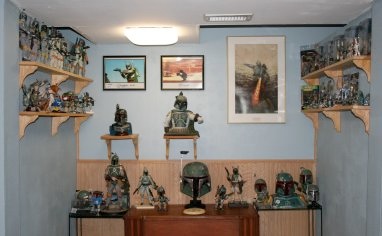
© The XBFL 2006-2017, All Rights Reserved

